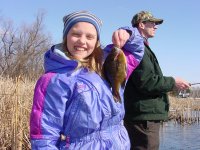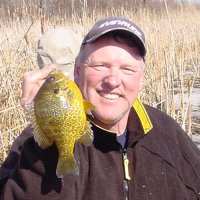|
Ah, spring is in the air. Rivers
are flowing, lakes are opening up and the panfish are already paying a visit
to their early spring hangouts to start another open water fishing season.
With all of the hubub that goes into getting ready for the fishing opener,
it can be easy to miss the signs of one of the season’s earliest fishing
opportunities. Here are a few simple tips that can help you cash in on a
bonus season that's already underway on a lot of Northern Minnesota lakes.

First tip, don't wait too long too long before you start looking. We all
have a tendency to wait until we hear from someone else that the fish have
started moving in spring, but this is one time when you want to be the first
one to find out if they're in. These brief forays into the shallows are
"pre-spawn" feeding movements, so the fish come and go as the food supplies
vary. There's no doubt that some days are better than others and it pays to
watch for the signs and try to be ready to go at your first chance. Warm;
sunny spring days work quickly to open the isolated back bays and channels
where panfish will make their first early season feeding runs. It's not
uncommon for the fish to move into these areas for a short time while
conditions are good, only to leave when the weather turns cloudy or colder.
One key tip is that you're looking for places that will warm quickly and
hold heat for a while. Locations like mud flats, weedbeds that contain
Coontail, Northern Milfoil or Cattails are all good examples of locations
where water will warm quickly producing early hatches of insects and
crustaceans that attract these early panfish. The key is the darker surfaces
that gather heat in a hurry. Even murky water can help to warm an area and
provide early feeding opportunities for panfish. These areas will often open
up several days or more before the ice breaks up on the main lake and it's
not uncommon to catch fish in these spots within a day or two after break
up. Narrow channels, inlets and boat harbors are also good places to search
during spring break up.
Clear water, hard bottom areas with sand or gravel are not likely to produce
these early season panfish, but keep an eye on areas with heavy Bulrushes or
areas with a soft cover over sand. In a few weeks, panfish will begin using
these areas as they prepare to spawn. I like to make a trip into some of
these shallow areas and look for last years "spawning beds", the shallow
dish-like depressions that panfish create by fanning the soft material away
from the harder bottom below it. When I locate these old-spawning areas,
I'll make note of them and remember to return when the water warms and
spawning begins. Even then, the fish will move in and out with the changing
weather conditions.
It pays to gear up for variety because this early breakup pattern can work
for Crappies, Bluegills and Perch. So depending on the lake or river stretch
that you fish, it's possible to catch any of these fish in and around the
same general area. It's good to have a variety of baits in case you stumble
into an unexpected group of fish that you weren't looking for. Minnows are
generally better for Crappies and Perch, while waxworms, angleworms or other
grubs are better suited for Bluegill. Plain hooks, small jigs or even ice
flies will all work and during early spring. Marabou and other small feather
jigs add to the natural attractive qualities and are among my favorite jigs
for spring bluegill fishing. I believe darker, more natural colors will
often produce fish better than the brightly colored jigs we use for ice
fishing.
It's important to remember that these fish are already coming into the
shallows to feed, so colorful, attracting baits are less important than at
other times. This is a time when we should put more emphasis on baits that
look like real food. This will help trigger more bites from the feeding
panfish. Combinations with Purple, Brown, Black and Plain White are all
colors that work well for me in springtime.
 |
A few bobbers and a nice long rod
rigged with 4 pound test line is plenty to get you started. Because you’re
fishing in such shallow water, you'll usually need floats to keep your bait
in the strike zone and out of the mud. I like the small Thill slip bobbers
from Lindy, it’s a nice balsa wood float with decent weight for casting,
they’re brightly colored and my line always feeds out smoothly.
Rods for
this light tackle need to be lightweight, sensitive and long enough to cast
small baits effectively. I like G.Loomis Rods, so I use their seven foot
SR-842 for this. The extra length allows me to get the light baits out
farther and make setting the hook easier too. I consider this to be one of
the ultimate fishing rods anywhere and I use it in many other situations
where light line and small jigs are required. No matter which rod you
choose, longer and lighter will generally fit the circumstances. Too heavy
or too short makes it harder to cast these light baits and makes it harder
to protect your light line from breaking.

Before you start packing all of your gear in the boat, consider that
early spring fishing for panfish might just be one of the few times each
year when folks fishing from some shore spots could have an advantage over
those of us out in the boat. Narrow channels, inlets and boat harbors are
well suited to fishing from shore and so are the popular public fishing
piers. The shore angler has two main advantages; first it's easier to fish
quietly and second, fish that are hooked and reeled toward the shore have
the effect of drawing other fish in with them. This helps to keep fish in
the area for longer periods of time and allows the angler to spend his
fishing time really efficiently. Often, the fishing will actually get better
as the day goes on.
Fishing these areas by boat can still be effective and there are plenty
of good areas that can only be reached by boat, but you’ll want to be
careful not to have too much unnecessary commotion causing noises that will
“spook” the fish moving them back out into the lake. In the past we’ve seen
schools of fish move out ahead of the boat and eventually escape around us
and return to the safety of the main lake. Once they leave, they don’t come
back for a while, so it's important to keep a low profile. Occasionally,
it’s a good idea to find the spot by boat, then once located, you can beach
the boat and fish from shore. Anchoring is also helpful when you want to
fish from a stationary position.
Once we locate an area that looks “fishy”, we'll begin by fishing the areas
nearest the main lake first. Then we'll move further into the channel in the
hope that any fish we move will head toward the shore instead of away from
it. Make long casts toward the center of the channel and give the jig a
series of sharp twitches then let it settle for a few seconds. Retrieve a
couple of feet of line and repeat the twitching/settling. This seems to be a
good compromise between attracting the
fish and giving them an opportunity to strike. We gradually move further in
to the bay or inlet until we either contact fish or decide to move to a new
location. We will change baits and colors often enough to be sure that we’ve
presented a good mixture. Fish the area thoroughly, but quickly. Fish coming
into these areas will generally be aggressive. If you don't find them in a
half-hour or so, it's time to move to a new location and try again.
When you make a trip on a day where the fish just don’t seem to be in, move
out to the first break into deeper water adjacent to the shallower feeding
areas. Panfish will use these deeper holes as a staging area at times when
cold weather blows in and interrupts their feeding routine. Fishing
vertically along the deeper edges of these breaks can get you back on fish
until they make their next move into the shallows. Remember that shallow
water that warms quickly is also likely to cool quickly when the conditions
change. The fish adapt to these changes and move in hurry.
So there you have it, not too complex and perfect for fighting off that case
of "spring fever". To me there's never a more rewarding fishing trip than
that first time out in the spring. Why not move up your schedule and be one
of the first ones to get out? I hope you'll pack up the family and give it a
try this year. Chances are you’ll be glad you did. |
